Cell-based kinase assays in HTS Benjamin Bader
Cell-based kinase assays in HTS Benjamin Bader
Cell-based kinase assays in HTS Benjamin Bader
You also want an ePaper? Increase the reach of your titles
YUMPU automatically turns print PDFs into web optimized ePapers that Google loves.
<strong>Cell</strong>-<strong>based</strong> <strong>k<strong>in</strong>ase</strong> <strong>assays</strong> <strong>in</strong> <strong>HTS</strong><br />
Potential and limitations for primary and secondary screen<strong>in</strong>g<br />
Benjam<strong>in</strong> <strong>Bader</strong><br />
HTRF-symposium Avignon 25. April 2013<br />
1 HTRF-symposium 2013<br />
11<br />
1
• Introduction<br />
• General considerations cell-<strong>based</strong> <strong>k<strong>in</strong>ase</strong> <strong>assays</strong><br />
• EFC-<strong>assays</strong> for Tyr-K<strong>in</strong>ases<br />
• TR-FRET systems: HTRF and Lanthascreen<br />
<strong>assays</strong> for the PI3K / Akt / mTOR pathway<br />
• Summary & conclusions<br />
2 HTRF-symposium 2013<br />
21<br />
2
K<strong>in</strong>ases as drug targets<br />
cAbl and Gleevec (Noble 2004)<br />
(Fabbro 2012)<br />
recent additions<br />
Vandetanib VEGFR, EGFR, RET thyroid AstraZeneca<br />
Vemurafenib B-RafV600E melanoma Roche/Plexxikon<br />
Regorafenib multiK<strong>in</strong>ase colorectal Bayer<br />
Critoz<strong>in</strong>ib ALK, ROS1 NSCLC Pfizer<br />
Bosut<strong>in</strong>ib BCR/Abl CLL Pfizer<br />
Ruxolit<strong>in</strong>ib JAK1/2 Myelofibrose Incyte/Novartis<br />
• human k<strong>in</strong>ome: 518 prote<strong>in</strong> <strong>k<strong>in</strong>ase</strong>s<br />
+ 20 lipid <strong>k<strong>in</strong>ase</strong>s (Mann<strong>in</strong>g 2002)<br />
• currently, ~150 <strong>k<strong>in</strong>ase</strong> targeted drugs are<br />
<strong>in</strong> cl<strong>in</strong>cal development (Fabbro 2012)<br />
• most registered <strong>k<strong>in</strong>ase</strong> drugs target<br />
Tyros<strong>in</strong>e <strong>k<strong>in</strong>ase</strong>s, with more Ser/Thr<br />
<strong>k<strong>in</strong>ase</strong> targetd drugs <strong>in</strong> the pipel<strong>in</strong>e<br />
• most <strong>k<strong>in</strong>ase</strong> drugs target the ATP-pocket<br />
• ma<strong>in</strong> <strong>in</strong>dication: oncology<br />
3 HTRF-symposium 2013<br />
31<br />
3
K<strong>in</strong>ase Inhibitors <strong>in</strong> the BAYER Development Pipel<strong>in</strong>e<br />
4 HTRF-symposium 2013<br />
41<br />
4
Features of a typical early <strong>k<strong>in</strong>ase</strong> drug discovery project<br />
u<strong>HTS</strong> phase<br />
1°u<strong>HTS</strong><br />
• Biochemical target <strong>k<strong>in</strong>ase</strong> assay<br />
Retest confirmation<br />
• Biochemical target <strong>k<strong>in</strong>ase</strong> assay<br />
• specificity detection control assay<br />
Dose response<br />
• Biochemical target <strong>k<strong>in</strong>ase</strong> assay<br />
• Off-target assay, selectivity assay<br />
• Mode-of-action <strong>assays</strong>: competitive<br />
ATP, slow b<strong>in</strong>d<strong>in</strong>g<br />
# compounds<br />
3 Mio<br />
30.000<br />
3.000<br />
(<strong>HTS</strong>-hitlist)<br />
cell-<strong>based</strong> mechanistic assay<br />
correlation mechanistic – biochemical<br />
hit-to-lead phase<br />
<strong>Cell</strong>-<strong>based</strong> mechanistic assay<br />
downstream substrate phosphorylation<br />
or def<strong>in</strong>ed cellular phenotype<br />
<strong>Cell</strong>-<strong>based</strong> functional <strong>assays</strong><br />
proliferation, cytok<strong>in</strong>es, migration etc.<br />
Pharmacok<strong>in</strong>etics<br />
In vivo efficacy<br />
lead compound<br />
300-1000<br />
300-1000<br />
30-100<br />
3<br />
biochemical <strong>k<strong>in</strong>ase</strong> assay<br />
• specific cell-<strong>based</strong> <strong>k<strong>in</strong>ase</strong> <strong>assays</strong><br />
are essential for hit profil<strong>in</strong>g dur<strong>in</strong>g<br />
hit-to-lead phase<br />
• <strong>in</strong>tegration of cell-<strong>based</strong> <strong>k<strong>in</strong>ase</strong><br />
<strong>assays</strong> as early as possible, best<br />
case even before hitlist delivery<br />
5 HTRF-symposium 2013<br />
51<br />
5
Requirements for efficient assay support <strong>in</strong> <strong>HTS</strong><br />
and Hit-to-lead phase @ BAYER<br />
Key objectives for every assay<br />
automated preparation of<br />
assay-ready plates<br />
(except HCA sta<strong>in</strong><strong>in</strong>g procedures)<br />
- assay-ready plates<br />
- 1536 well format, at least 384 well<br />
cells and reagent<br />
dispens<strong>in</strong>g <strong>in</strong>to 1536 well<br />
plates addition-only<br />
- homogenous addition only<br />
- endpo<strong>in</strong>t <strong>assays</strong><br />
- frozen cells<br />
- short<br />
- robust<br />
endpo<strong>in</strong>t detection<br />
with imag<strong>in</strong>g-<strong>based</strong><br />
multimode-readers<br />
6 HTRF-symposium 2013<br />
61<br />
6
General options for cell-<strong>based</strong> <strong>k<strong>in</strong>ase</strong> <strong>assays</strong><br />
Assay technology Provider comments critical tools<br />
Western Blot various heterogenous<br />
low throughput<br />
phospho-antibody<br />
Incell Western various high content imag<strong>in</strong>g phospho-antibody<br />
ELISA-type various heterogenous antibody pair<br />
Lum<strong>in</strong>ex Millipore heterogenous antibody pair<br />
Surefire / ALPHAscreen Perk<strong>in</strong>Elmer homogenous antibody pair<br />
HTRF Cisbio homogenous antibody pair<br />
Lanthascreen LifeSciences homogenous phospho-antibody<br />
recomb<strong>in</strong>ant cell-l<strong>in</strong>e<br />
EFC - Enzyme Fragment<br />
Complementation<br />
Survival assay<br />
DiscoveRx homogenous antibody-free<br />
recomb<strong>in</strong>ant cell-l<strong>in</strong>e<br />
Advanced <strong>Cell</strong>ular<br />
Dynamics / Carna<br />
Tyr-<strong>k<strong>in</strong>ase</strong> activity restores<br />
survival of Ba/F3 cells<br />
antibody-free<br />
recomb<strong>in</strong>ant cell-l<strong>in</strong>e<br />
Pathway reporter <strong>assays</strong> various downstream gene activation antibody-free<br />
recomb<strong>in</strong>ant cell-l<strong>in</strong>e<br />
7 HTRF-symposium 2013<br />
71<br />
7
EFC-<strong>assays</strong> for Tyr-K<strong>in</strong>ases (DiscoveRx)<br />
Technology EFC (enzyme fragment complementation)<br />
EphB4 cellular <strong>k<strong>in</strong>ase</strong> activity assayed us<strong>in</strong>g an enzymatic prote<strong>in</strong> <strong>in</strong>teraction system<br />
(Wehrman et al. 2013 ADT)<br />
Agonist stimulation Validation with <strong>k<strong>in</strong>ase</strong> <strong>in</strong>hibitors Frozen cell and direct assay format<br />
EFC<br />
modified from www.discoverx.com<br />
• EFC-<strong>k<strong>in</strong>ase</strong> technology is suitable for m<strong>in</strong>iaturized frozen cell <strong>assays</strong><br />
• limitations: largely restricted to Tyros<strong>in</strong>e <strong>k<strong>in</strong>ase</strong>s, requires recomb<strong>in</strong>ant cells<br />
8 HTRF-symposium 2013<br />
81<br />
8
TR-FRET systems: HTRF and Lanthascreen<br />
Activation<br />
Lysis<br />
P<br />
P<br />
cell l<strong>in</strong>e<br />
express<strong>in</strong>g GFP-X<br />
(<strong>k<strong>in</strong>ase</strong> target)<br />
Tb<br />
Detection of<br />
phosphorylated prote<strong>in</strong><br />
P<br />
modified from www.htrf.com<br />
modified from www.<strong>in</strong>vitrogen.com<br />
HTRF<br />
• endogenous phospho-prote<strong>in</strong><br />
• any cell l<strong>in</strong>e express<strong>in</strong>g prote<strong>in</strong><br />
• antibody pair required<br />
• HTRF-detection at 620/665 nm<br />
Lanthascreen<br />
• overexpressed GFP-phospho-prote<strong>in</strong><br />
• stable cell l<strong>in</strong>e or BacMam transient<br />
• only phospho antibody required<br />
• Lanthascreen detection at 490/520<br />
9 HTRF-symposium 2013<br />
91<br />
9
HTRF and Lanthascreen <strong>assays</strong> for<br />
the PI3K / Akt / mTOR pathway<br />
10 HTRF-symposium 2013<br />
101<br />
10
Introduc<strong>in</strong>g the PI3K / Akt / mTOR pathway<br />
• PI3K / Akt pathway is central to cancer formation<br />
• Chemotherapeutic approaches aga<strong>in</strong>st multiple<br />
targets are <strong>in</strong> the pipel<strong>in</strong>es<br />
Liu 2009 Nat. Rev Drug Discovery<br />
11 HTRF-symposium 2013<br />
111<br />
11
Assay<strong>in</strong>g the PI3K / Akt / mTOR pathway<br />
Lanthascreen study goals:<br />
• Evaluate BacMam Lanthascreen technology<br />
• GFP-Akt @ two sites (pT308 and pS473)<br />
• GFP-PRAS40 @ two sites (S183 and T246)<br />
• test different cell backgrounds<br />
• validate with reference <strong>in</strong>hibitors<br />
HTRF study goals:<br />
• set up cell-<strong>based</strong> mTOR <strong>k<strong>in</strong>ase</strong> activity<br />
assay for <strong>HTS</strong><br />
• identify optimal cancer cell background<br />
• validate with reference <strong>in</strong>hibitors<br />
validate <strong>HTS</strong>-compatibility with<br />
both formats us<strong>in</strong>g a m<strong>in</strong>iaturized<br />
384 well focussed screen<br />
(modified from Carlson 2009)<br />
12 HTRF-symposium 2013<br />
121<br />
12
Lanthascreen Assay Development<br />
BacMam technology comb<strong>in</strong>ed with<br />
Lanthascreen <strong>Cell</strong>ular assay<br />
mammalian<br />
cells<br />
(modified from Kost 2007, Carlson 2010)<br />
13 HTRF-symposium 2013<br />
131<br />
13
Lanthascreen – cellular background<br />
Lanthascreen study goals:<br />
• Evaluate BacMam Lanthascreen technology<br />
• GFP-Akt @ two sites (pT308 and pS473)<br />
• GFP-PRAS40 @ two sites (S183 and T246)<br />
• test different cell backgrounds<br />
• validate with reference <strong>in</strong>hibitors<br />
<strong>Cell</strong> l<strong>in</strong>e Type PI3K Pathway<br />
mutation<br />
PC-3<br />
MCF-7<br />
MDA-MB-<br />
453<br />
KPL-4<br />
HEK-293<br />
U2-OS<br />
Human prostate<br />
cancer<br />
Human breast<br />
cancer<br />
Human embryonal<br />
kidney<br />
Human<br />
osteosarcoma<br />
PTEN negative<br />
PI-3-K<strong>in</strong>ase<br />
mutation<br />
E545K<br />
PI-3-K<strong>in</strong>ase<br />
mutation<br />
H1047R<br />
WT<br />
WT<br />
Ratio Stimulated / <strong>in</strong>hibited<br />
10.0<br />
9.0<br />
8.0<br />
7.0<br />
6.0<br />
5.0<br />
4.0<br />
3.0<br />
2.0<br />
1.0<br />
0.0<br />
Akt-pS473 Akt-pT308<br />
PRAS40-pT246 PRAS40 pS183<br />
MCF7 PRAS40-pT246 selected for<br />
further optimization work<br />
14 HTRF-symposium 2013<br />
141<br />
14
Lanthascreen – virus efficiency<br />
30% virus<br />
S/B max = 7<br />
1% virus<br />
S/B max = 9<br />
10% virus<br />
S/B max = 2<br />
1% virus<br />
S/B max = 3<br />
• different virus efficiency: PRAS40 with highly efficient expression (S/B max reached at 1%)<br />
• differences between phosphosites antibody quality (?)<br />
15 HTRF-symposium 2013<br />
151<br />
15
Lanthascreen – cellular background<br />
PTEN negative<br />
PI3K E545K<br />
• PC3-cells - <strong>in</strong> contrast to MCF7 - have fully stimulated pathway<br />
cave different pathway mutations have different impact on basal activation<br />
16 HTRF-symposium 2013<br />
161<br />
16
Lanthascreen - optimization<br />
• stimulation time<br />
• stimulation temperature<br />
• antibody concentration<br />
• time cell lysis read<br />
• DMSO sensitivity<br />
• Volume 10 µl 5 µl<br />
• frozen cells<br />
17 HTRF-symposium 2013<br />
171<br />
17
Lanthascreen - optimized assay protocol<br />
day 1:<br />
seed cells <strong>in</strong>to of MCF7 cells T-flask (frozen or cont<strong>in</strong>uous culture)<br />
day 2:<br />
transduce MCF7 cells with 1% PRAS40 virus <strong>in</strong> T-flask<br />
day 3:<br />
harvest transduced cells and prepare cell suspension <strong>in</strong> medium + 1% FCS<br />
dispense 3 µl (5000 cells/well) <strong>in</strong>to assay-ready MTP conta<strong>in</strong><strong>in</strong>g 50 nl cpd.<br />
2 h @ 37°C<br />
add 1 µl lysis/detection mix<br />
2 h @ RT<br />
read TR-FRET<br />
18 HTRF-symposium 2013<br />
181<br />
18
Lanthascreen - <strong>in</strong>hibitor validation PRAS40-pT246<br />
MK-2206<br />
allosteric Akt <strong>in</strong>hibitor<br />
PI-103<br />
PI3K <strong>k<strong>in</strong>ase</strong> <strong>in</strong>hibitor<br />
4000<br />
4000<br />
3000<br />
3000<br />
Ratio<br />
2000<br />
Ratio<br />
2000<br />
1000<br />
1000<br />
0<br />
10 -10 10 -9 10 -8 10 -7 10 -6 10 -5<br />
MK-2206 [M]<br />
• potency of pathway<br />
<strong>in</strong>hibitors depends on<br />
<strong>in</strong>cubation time<br />
• Akt and mTOR <strong>in</strong>hibitors<br />
improved IC50 after 2 h<br />
Ratio<br />
4000<br />
3000<br />
2000<br />
1000<br />
0<br />
10 -10 10 -9 10 -8 10 -7 10 -6 10 -5<br />
PI-103 [M]<br />
AZD-8055<br />
mTOR <strong>k<strong>in</strong>ase</strong> <strong>in</strong>hibitor<br />
0<br />
10 -10 10 -9 10 -8 10 -7 10 -6<br />
AZD-8055 [M]<br />
19 HTRF-symposium 2013<br />
191<br />
19
HTRF – assay<br />
HTRF study goals:<br />
• set up cell-<strong>based</strong> mTOR <strong>k<strong>in</strong>ase</strong> activity<br />
assay for <strong>HTS</strong> us<strong>in</strong>g pAkt Ser473 readout<br />
• identify optimal cancer cell background<br />
• validate with reference <strong>in</strong>hibitors<br />
Detection<br />
(modified from Carlson 2009)<br />
(from Cisbio product <strong>in</strong>sert)<br />
20 HTRF-symposium 2013<br />
201<br />
20
HTRF – cell l<strong>in</strong>es<br />
18000<br />
Ratio<br />
16000<br />
14000<br />
12000<br />
10000<br />
8000<br />
6000<br />
4000<br />
cont<strong>in</strong>uous<br />
culture<br />
frozen<br />
cells<br />
• MCF7 cells strongest S/B<br />
• frozen cell assay<br />
• suspension cell format<br />
• m<strong>in</strong>iaturized to 1536 well<br />
2000<br />
0<br />
10 -10 10 -9 10 -8 10 -7 10 -6<br />
AZD 8055 [M]<br />
21 HTRF-symposium 2013<br />
211<br />
21
HTRF - optimized assay protocol<br />
day 1:<br />
thaw frozen MCF7 cells and prepare cell suspension <strong>in</strong> medium + 1% FCS<br />
dispense 3 µl (4000 cells/well) <strong>in</strong>to assay-ready MTP conta<strong>in</strong><strong>in</strong>g 50 nl cpd.<br />
30 m<strong>in</strong> @ 37°C<br />
add 1 µl lysis buffer<br />
1 h @ RT shake<br />
add 4 µl antibody detection mix<br />
20 h @ RT<br />
day 2:<br />
read TR-FRET<br />
22 HTRF-symposium 2013<br />
221<br />
22
HTRF – pathway <strong>in</strong>hibitor validation<br />
MCF7 cells<br />
AKT <strong>in</strong>hibitor<br />
MK-2206<br />
PI3K <strong>in</strong>hibitor<br />
PI-103<br />
IC50 = 635nM<br />
IC50 = 79nM<br />
mTORC1 <strong>in</strong>hibitor<br />
Rapamyc<strong>in</strong><br />
mTOR <strong>in</strong>hibitor<br />
Ku-0063794<br />
mTOR <strong>in</strong>hibitor<br />
AZD 8055<br />
no effect<br />
IC50 = 163nM<br />
IC50 = 7nM<br />
23 HTRF-symposium 2013<br />
231<br />
23
Focussed medium throughput screen:<br />
• BacMAM Lantha PRAS40-pT246<br />
• HTRF Akt-pS473<br />
• 24.300 compounds, <strong>k<strong>in</strong>ase</strong> targeted library<br />
• 384 well s<strong>in</strong>gle format<br />
• 69 MTPs<br />
• 5 parallel assay runs (Lantha and HTRF)<br />
24 HTRF-symposium 2013<br />
241<br />
24
Focussed medium throughput screen<br />
28000<br />
26000<br />
24000<br />
22000<br />
20000<br />
shape by assay:<br />
HTRF<br />
Ratio<br />
18000<br />
16000<br />
14000<br />
12000<br />
Lanthascreen<br />
10000<br />
8000<br />
6000<br />
4000<br />
2000<br />
HTRF<br />
color by run<br />
5000<br />
10 -10 10 -9 10 -8 10 -7 10 -6<br />
AZD-8055 [M]<br />
4000<br />
3000<br />
Ratio<br />
2000<br />
1000<br />
0<br />
Lantha<br />
10 -10 10 -9 10 -8 10 -7 10 -6<br />
AZD-8055 [M]<br />
• Similar sensitivity of both <strong>assays</strong> ag<strong>in</strong>st mTORi<br />
• HTRF: stable and robust assay performance<br />
• Lanthascreen: day-to-day variability <strong>in</strong> S/B<br />
25 HTRF-symposium 2013<br />
251<br />
25
Focussed medium throughput screen<br />
Distribution neutral controls:<br />
Distribution compounds / donor <strong>in</strong>terference:<br />
• Neutral controls: similar distribution for both <strong>assays</strong><br />
• Compounds: strong <strong>in</strong>terference <strong>in</strong> BacMAM donor channel<br />
26 HTRF-symposium 2013<br />
261<br />
26
Focussed medium throughput screen<br />
Lantha<br />
Assay<br />
common<br />
hits<br />
HTRF<br />
Assay<br />
<strong>in</strong>terference<br />
4686 cpds / 19%<br />
24.228<br />
<strong>in</strong>terference<br />
282 cpds / 1%<br />
Lantha<br />
HTRF<br />
Hits > 30% @ 10 µM<br />
(1.6%)<br />
294<br />
15<br />
(0.3%)<br />
63<br />
available for retest<br />
255 5 34<br />
Interference<br />
Hit rate<br />
high<br />
(19%)<br />
high<br />
(1.6%)<br />
low<br />
(1%)<br />
low<br />
(0.3%)<br />
Confirmed hits<br />
(12%) confirmation rate (62%)<br />
24 5 18<br />
Confirmation rate<br />
low<br />
(12%)<br />
high<br />
(62%)<br />
available for IC50<br />
28 3 11<br />
(31%) confirmation rate (57%)<br />
IC50 hits<br />
7 2 6<br />
27 HTRF-symposium 2013<br />
271<br />
27
Summary & Conclusions<br />
• K<strong>in</strong>ases rema<strong>in</strong> <strong>in</strong>terest<strong>in</strong>g target class <strong>in</strong> pharmaceutical research<br />
• Specific and efficient cell-<strong>based</strong> <strong>k<strong>in</strong>ase</strong> <strong>assays</strong> are essential <strong>in</strong> pharma<br />
research projects<br />
• Homogenous assay systems fit best to Bayers lead discovery platform<br />
• Positive experience at Bayer with EFC-technology, HTRF and<br />
Lanthascreen<br />
• EFC-technology <strong>in</strong>terest<strong>in</strong>g for Tyr-K<strong>in</strong>ase u<strong>HTS</strong><br />
• Lanthascreen technology positioned for secondary test<strong>in</strong>g<br />
• HTRF positioned for u<strong>HTS</strong> and secondary test<strong>in</strong>g<br />
28 HTRF-symposium 2013<br />
281<br />
28
Acknowledgements<br />
Anja Kretzschmar<br />
Sabr<strong>in</strong>a Reimann<br />
Katr<strong>in</strong> Nowak-Reppel<br />
Dagmar Zeggert-Spr<strong>in</strong>ger<br />
Karsten Parczyk<br />
Monika Gross (Beuth University of Applied Science)<br />
data published <strong>in</strong> master thesis of Anja Kretzschmar, November 2011<br />
29 HTRF-symposium 2013<br />
291<br />
29
Thank you!


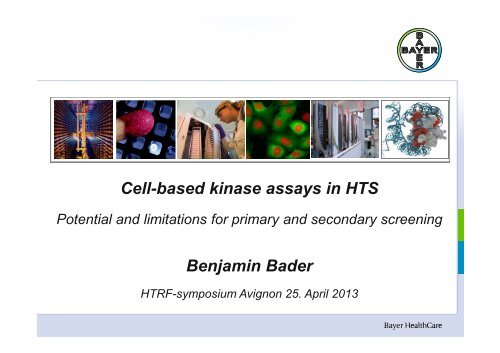
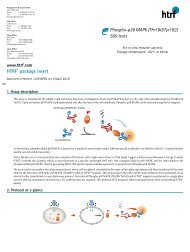

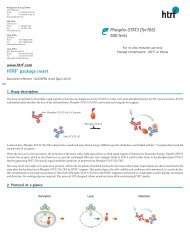
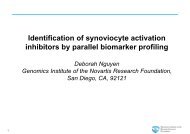
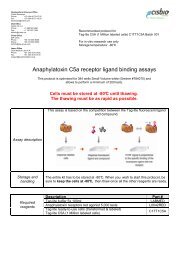
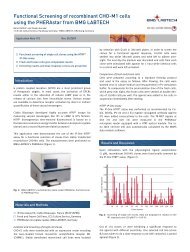
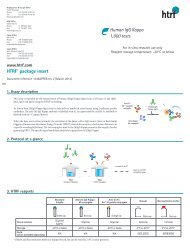
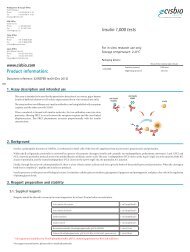

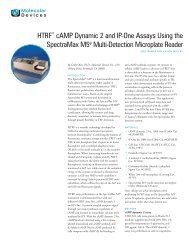
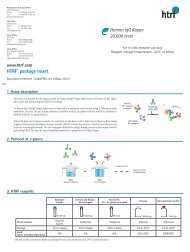
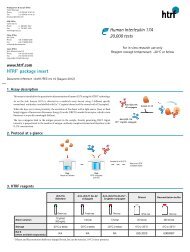

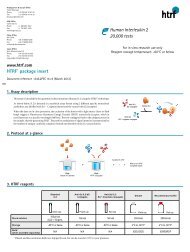
![HTRF meeting_130426_villa_pour pdf [Mode de compatibilité]](https://img.yumpu.com/22345646/1/190x135/htrf-meeting-130426-villa-pour-pdf-mode-de-compatibilitac.jpg?quality=85)